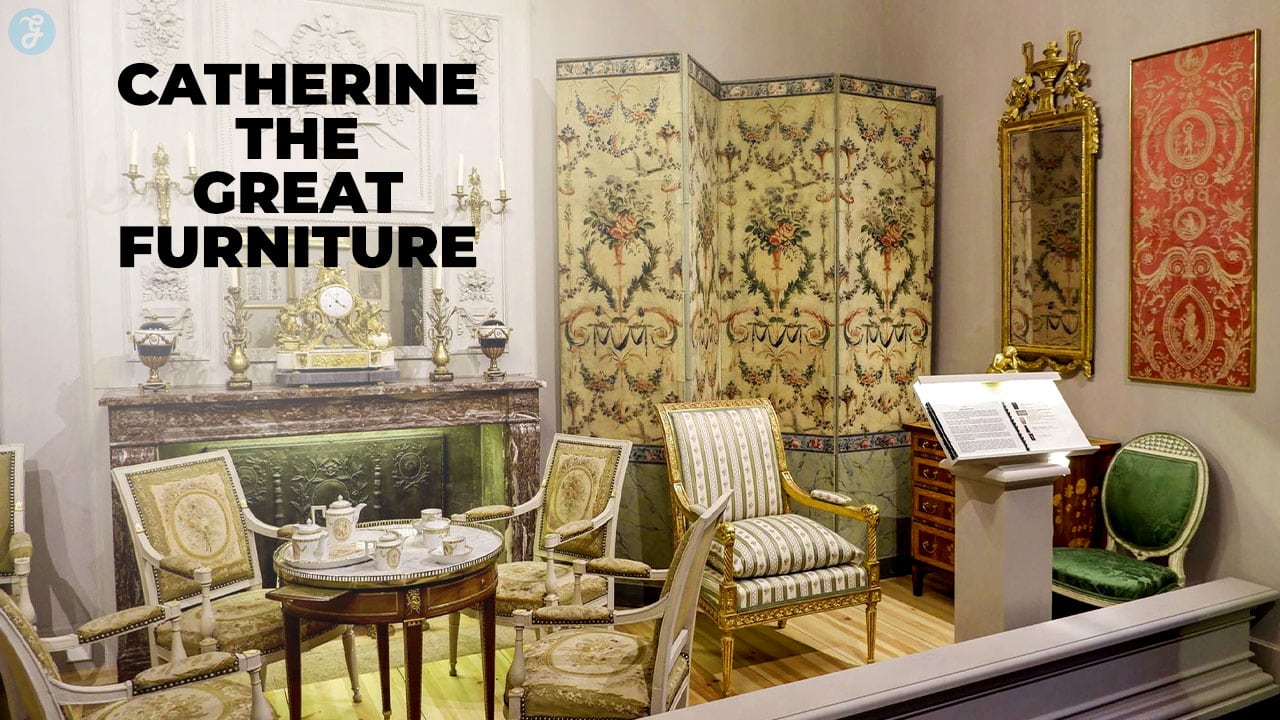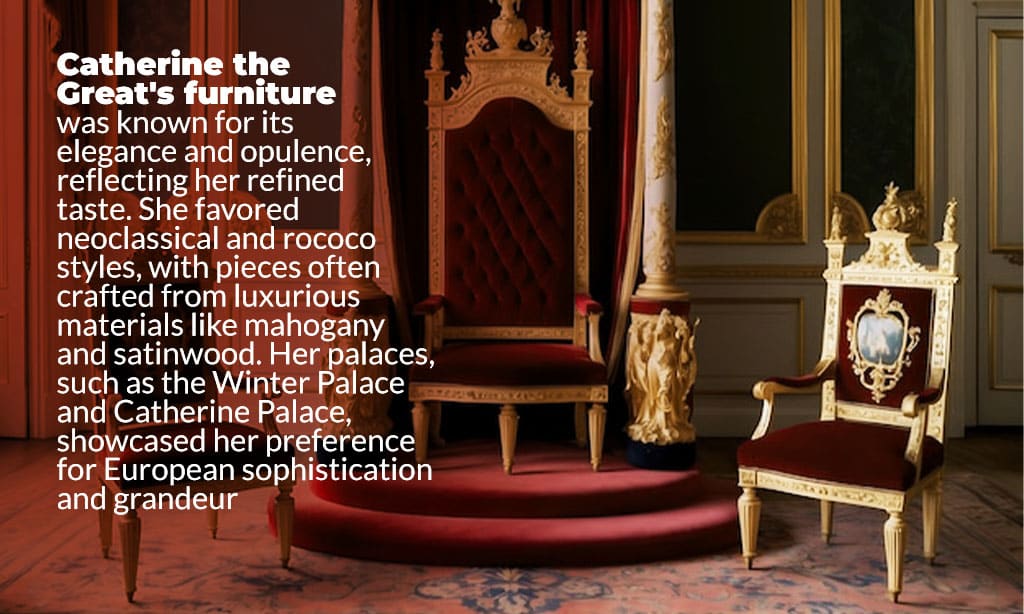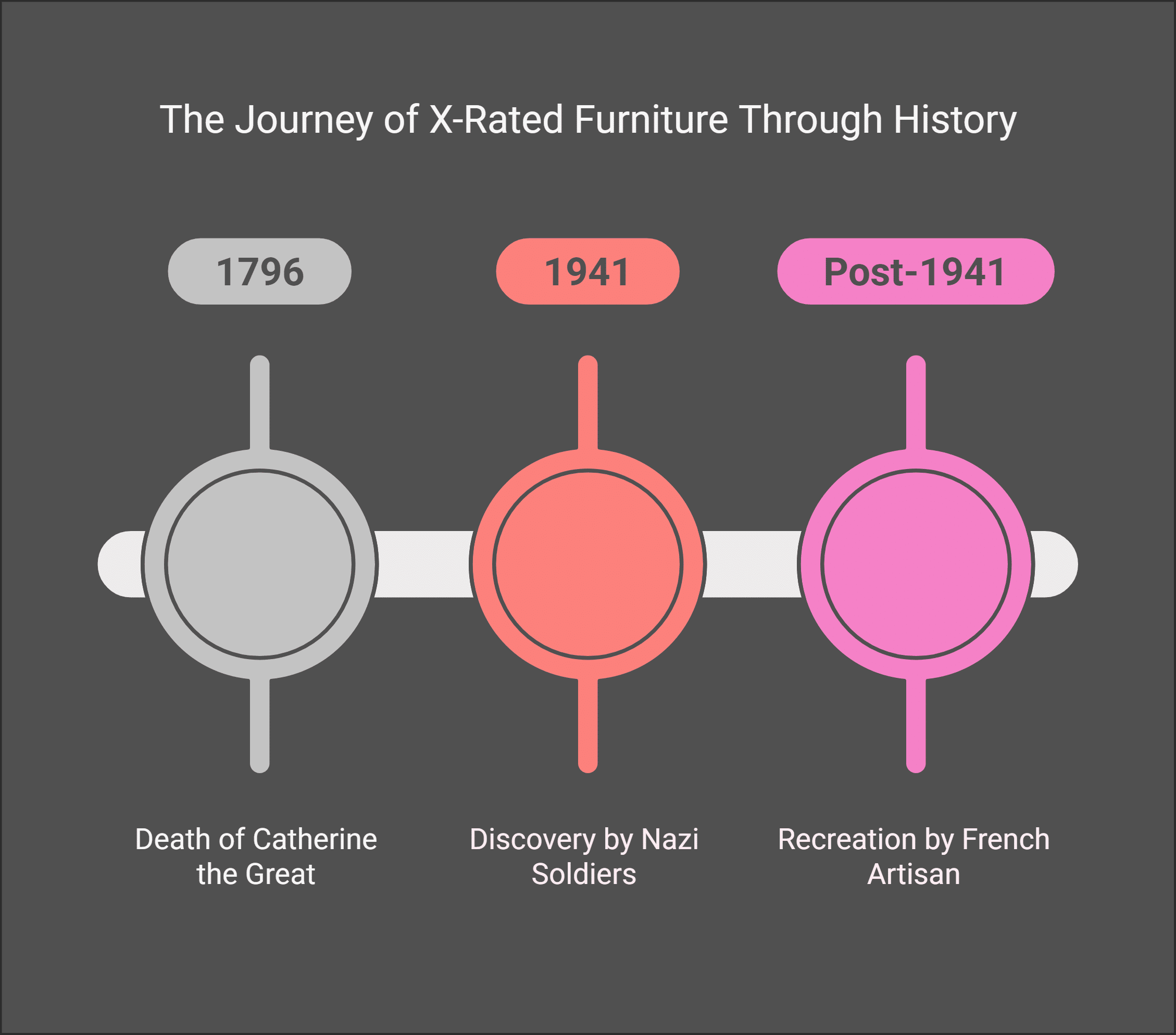Are you curious about the mysterious and bold side of Catherine The Great Furniture? This Russian Empress wasn’t just a ruler; she left behind stories as grand as her reign, including her jaw-dropping furniture.
In this post, we’ll explore how her legendary X-rated designs blended art, history, and shocking rumors. Stick around—it’s unlike anything you’ve ever read!
Key Takeaways
- Catherine the Great furniture blended Baroque and Rococo influences with rich details like gold accents and floral patterns, reflecting her love for European art.
- She reportedly had erotic designs in a secret “sex room,” featuring carvings of intertwined human forms and sexual imagery symbolizing fertility or strength.
- After her death in 1796, her son Paul I hid these pieces due to their explicit nature, but many were destroyed during World War II.
- Nazi soldiers allegedly uncovered and photographed some of the controversial furniture during Operation Barbarossa in 1941.
- Modern replicas inspired by wartime photos now exist in museums like the Hermitage Museum, preserving her bold artistic legacy.
The Unique Craftsmanship of Catherine the Great Furniture
Catherine the Great furniture stood out for its bold and intricate artistry. Every piece blended opulent styles with themes that shocked and fascinated, making it unforgettable in design history.
Detailed Baroque and Rococo Influences
Russian palaces during Catherine II’s reign showcased strong Baroque and Rococo styles. These designs favored ornate decorations, pastel colors, and intricate patterns. The Empress of Russia admired these European trends and brought them into her furniture collection.
Her pieces often blended grand curves with floral details, echoing the opulence seen in French royal homes.
Catherine Palace in Tsarskoye Selo embodied these influences beautifully with its lavish interiors. Gold accents and porcelain played prominent roles throughout the palace decor. This artistic patronage highlighted Catherine’s dedication to blending Russian culture with Western art movements during her time as ruler of the Russian Empire.
Integration of Erotic and Symbolic Designs
Catherine the Great’s legendary erotic furniture combined sexual imagery with symbolic meaning. The designs included carvings of genitalia and intertwined human forms, crafted specifically for her private “sex room.” This bold artistic choice reflected her liberated views on sexuality and power as a female leader.
Many pieces also featured motifs symbolizing fertility or strength, blending erotic art with deeper themes.
After Catherine’s reign ended in 1796, these provocative designs were hidden by her son Paul I. He disapproved of such expressions in royal spaces. Political enemies spread rumors about this sensual furniture, fueling scandalous tales that persisted over time.
Their existence remains debated since most pieces were believed to have been destroyed during World War II’s chaos.
The Fascinating History of the X-Rated Furniture
The dirty furniture linked to Russian Empress Catherine the Great has a wild backstory. Hidden for decades, these scandalous pieces reportedly emerged during World War II. Soldiers from Nazi Germany’s Wehrmacht found and photographed them in 1941 while stationed near St.
Petersburg. The erotic cabinet and other items displayed explicit carvings and designs tied to human sexuality.
Paul I of Russia, her successor, ordered the entire collection hidden away after she died at age 67. Many rumors swirled about her private life, including bold claims about sexual vigor and lovers like Grigory Orlov or even Poniatowski of Poland.
Sadly, most pieces were destroyed due to bombings during Operation Barbarossa by the Nazis. Later, a skilled French artisan recreated some incredible copies using these wartime photographs as guides—keeping the legends alive in pornographic glory!
The Legacy and Reimaginations of the Designs Today
Catherine the Great furniture’s legacy still stirs curiosity. Her bold, explicit designs inspire both historians and artists. Recreated pieces now sit in museums like Saint Petersburg’s Hermitage Museum.
These reproductions preserve her daring spirit while showcasing Russian craftsmanship from the 18th century.
Modern media keeps her tale alive. Hulu’s “The Great” and HBO’s “Catherine the Great” highlight her rule and controversies, including myths of “incredibly dirty furniture.” Political enemies likely fueled these legends to tarnish her image, yet they remain iconic symbols of a sexually liberated woman in power.
Takeaways
Catherine the Great furniture shows her boldness, creativity, and complex personality. These pieces were more than art—they whispered secrets of power and passion. Though they may be gone now, their legend lives on, sparking curiosity and awe.
Her daring designs remind us that history is as wild as it is fascinating. Russia’s Golden Age truly had its share of surprises!
FAQs
1. What is Catherine the Great’s connection to wild x-rated furniture?
Catherine the Great, known as Empress of Russia, reportedly collected wild x-rated furniture. These designs were said to reflect her bold personality and legendary reputation for embracing unconventional ideas.
2. Did Catherine the Great really have a “sex room”?
Historical accounts suggest that an entire “sex room” existed in Catherine II’s bedroom. However, whether these claims are fact or legend remains debated among historians.
3. Where did this furniture first appear in modern discussions?
The story of Catherine’s wild x-rated furniture first appeared on Dornob, sparking curiosity about its origins and role in Russian culture during her reign.
4. How did legends about Catherine’s sexuality shape her image?
Legends like her supposed affair with a horse or tales of lovers such as Grigory Potemkin added to her larger-than-life persona. Though many stories lacked evidence, they persisted over time.
5. Was there truth behind rumors of Wehrmacht soldiers finding this furniture?
During World War II, when Soviet palaces were bombed by invading Wehrmacht soldiers, some claimed they discovered pieces tied to Catherine’s alleged collection. Whether these accounts are true is still unclear.
6. Why does Catherine remain a controversial figure today?
Her arranged marriage to Peter III ended in a coup d’état that made her ruler of Russia. Her long relationship with philosophy and higher education for women marked progress during the Golden Age but was overshadowed by rumors about affairs and sexual vigor that persist even now!









































